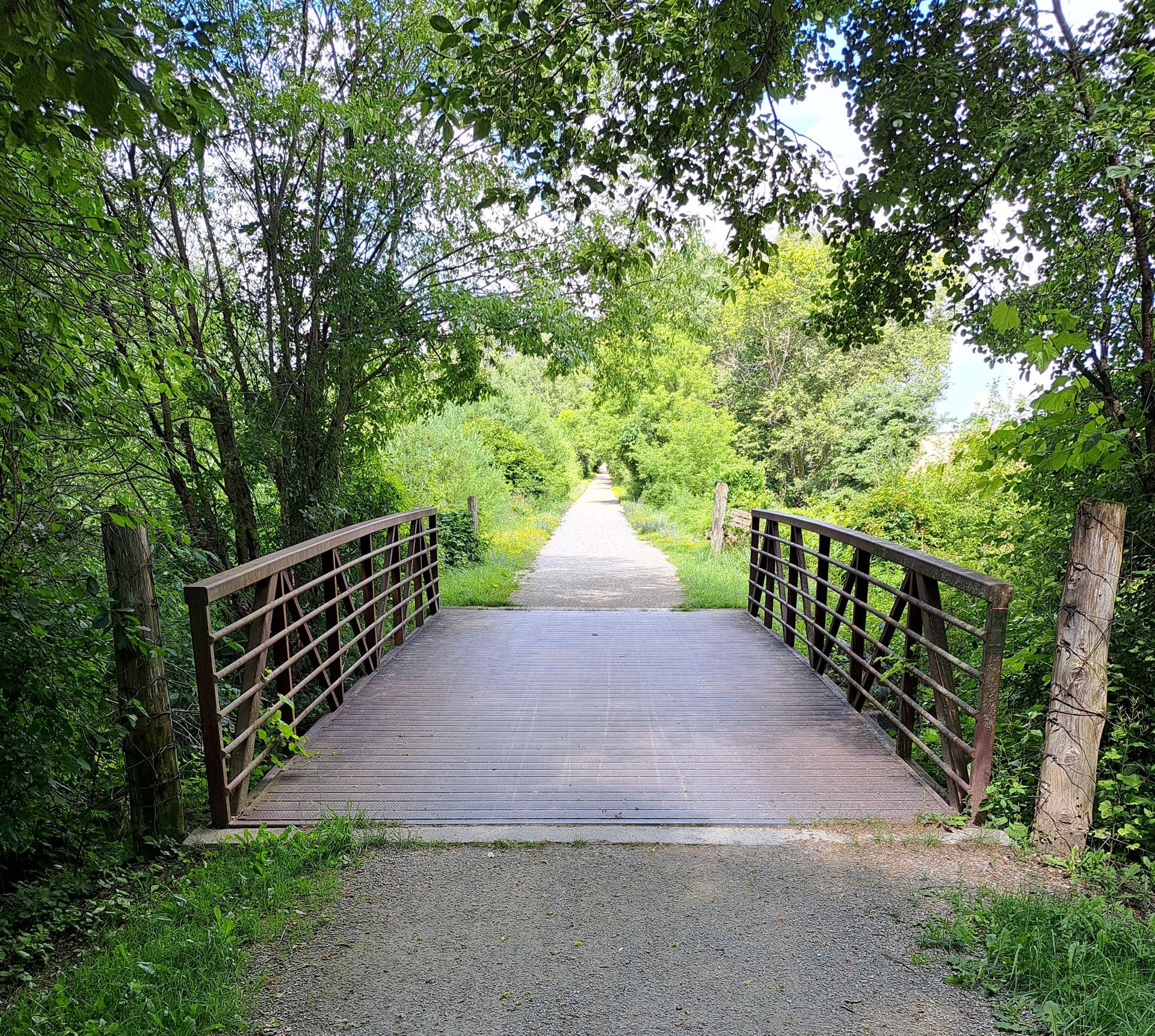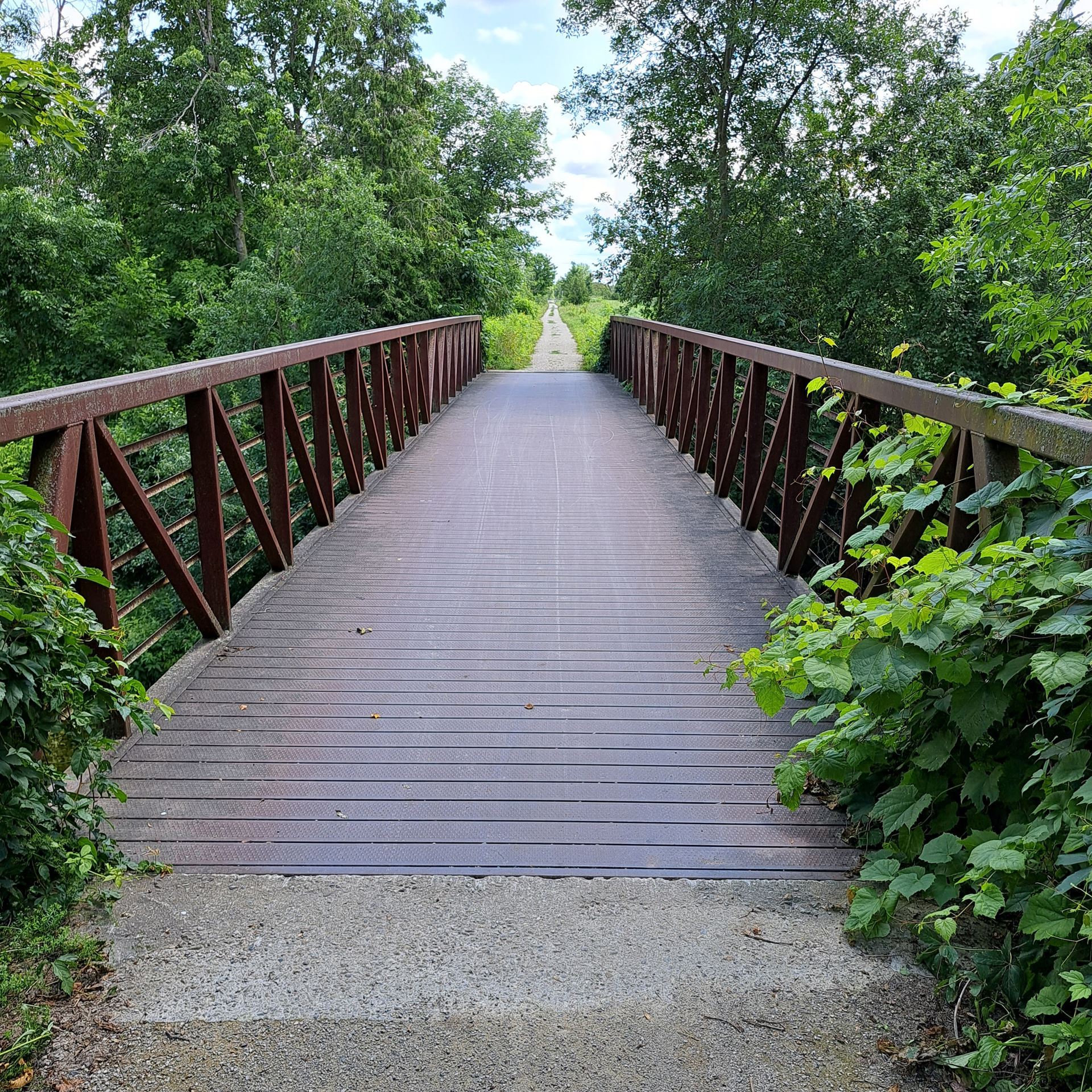|
- Home
- Trails
- Year of the Bridges
- Kissing Bridge Trailway Bridges
Kissing Bridge Trailway Bridges


By Liam Waterman, GHTC Volunteer
The Stonefields and Musagetes bridges span the Hopewell and Cox creeks, which intersect the Kissing Bridge Trailway (KBT) between Guelph and the Grand River. The KBT, maintained by the Guelph Hiking Trail Club (GHTC) in this section, is part of the broader G2G or “Guelph to Goderich” trail, which follows a section of the former Canada Pacific Railroad (CPR).1 The Musagetes and Stonefields bridges cover locations where older bridges had been removed by the CPR when the railroad was sold in 1988.2 Their existence is owed largely to the generous giving of Michael Barnstijn and Louise MacCallum, two local landowners and the founders of the Musagetes Fund, which has since continued to support the GHTC.
The history of these bridges is intimately connected to the history of the KBT itself.3 The GHTC was granted responsibility for the maintenance of their section of the KBT in 1998 by the County of Wellington, which had leased the trailway from the Province of Ontario.4 The province had purchased the former railroad to serve as a possible utility corridor for transporting water from Lake Huron, and in the meantime a multi-use trailway. At the time it was immediately clear that bridges would need to be installed on the trailway. The CPR had removed and either sold or scrapped all railway structures and equipment, including rails, ties, and bridges, when the railroad was sold. Hopewell Creek, which is located about 1 kilometer from the beginning of the KBT, was traversable over boards and stepping stones but only when water levels were low. Cox Creek, which crosses the KBT about 1.5 kilometers before it meets the Grand River, was completely impassable due to its significant water depth and steep banks. As a result, the section of the trailway around Cox Creek had to be rerouted via a road detour along line 86 to West Montrose.
While the GHTC intended to eventually install bridges over these creeks, they weren’t an immediate priority at the time, both due to the possible expense and the more pressing need for barrier gates and marker posts on the trailway. The Province of Ontario had mandated that any bridges on the trailway would need to be able to support a pickup truck, which would necessitate a professionally constructed steel bridge, rather than the simple wooden bridges present on other GHTC trails. Sections of the KBT are also open for snowmobiles, and therefore the bridge over the Hopewell Creek (though not Cox Creek) would need to be able to support the 10-ton groomer that the Golden Triangle Snowmobile Club used to keep their trails clear in the winter. Mike Curtis, the trail coordinator for the GHTC’s section of the KBT, asked Phil Kidston, Henry Graupner, and John Scott, all retired engineers, to survey the locations and create an estimate for the cost of bridge construction. The final number was 50 to 60 thousand dollars, well beyond the GHTC’s budget.
Plans for the construction of the Musagetes and Stonefields bridges did eventually begin in the spring of 2001, when funding suddenly became available. Mike Curtis recalls receiving a phone call from former GHTC president David Hull informing him that Michael Barnstijn and Louise MacCallum of the Musagetes Fund had offered a sizable donation to the GHTC to be put towards a future major project. Michael and Louise owned a property off of County Road 29 near Eden Mills, relatively close to the KBT. As former high-level employees at the software company Research in Motion or “RIM” (now Blackberry Limited), they were able to set up the Musagetes Fund in 2000, which continues to support a variety of community projects in the Guelph and Kitchener-Waterloo region.5 Mike Curtis informed David Hull of the projected cost of the bridges, and he passed it on to Michael and Louise, who offered $70,000 for bridge construction in the form of RIM shares. The GHTC promptly sold these shares and placed them in a two-year GIC to accrue interest. The intention was that the money from the GIC would be used to pay for the bridges in 2003. The Province of Ontario and the Grand River Conservation Authority both shortly granted permission for the GHTC to install these bridges, and, since the planned construction would not affect the water below, the federal Fisheries and Oceans Services also signed off on construction.
Mike Curtis and the GHTC executives chose Eagle Bridge Inc. to design and construct the bridges. Curtis notes that several Eagle Bridges were already in use by other organizations in the Guelph and Kitchener-Waterloo area, and that they were particularly appealing to the GHTC due to their low maintenance requirement. David Hull and Phil Kidston went out to measure the exact specifications needed for the bridges, which were then sent to Eagle. While the Stonefields bridge (over the Hopewell Creek) was designed to support 10 tons, the Musagetes bridge (over the Cox Creek) was designed to support only 5 tons. The existing abutments left at the creeks from the CPR were found to be of insufficient structural integrity, so the GHTC decided to install new abutments, which would be placed three feet further back from the water on either side. Construction on these abutments was undertaken by R&M Construction, an Acton-based general contracting company. Their work entailed digging out a trench on either side of each creek, and then placing a large concrete sleeper in each trench, to which the bridge would eventually be bolted. Because the KBT was once a railway, it was already completely flat, and thus the trail itself did not need to be raised or altered to meet the level of the bridge. For installation Eagle Bridge Inc. brought each bridge on a flatbed truck, along with a crane to lift the bridge onto its abutments. The accessibility of the trail to motor vehicles made this process particularly easy. The Hopewell Bridge was constructed first, and the Cox Bridge second, over the course of a few days in spring 2003. This was the end of bridge construction on the KBT.
The impact of these bridges has been significant for the KBT. Once they were installed the former road detour was removed, allowing the GHTC’s section of the trailway to solely follow the former rail line. The trailway was also made significantly more accessible, as users were no longer required to descend the banks of the Hopewell Creek and walk across stones and planks. The names for the bridges were chosen by the donors. “Stonefield,” given to the bridge over Hopewell Creek, is the name of Michael Barnstijn and Louise MacCallum’s farm. “Musagetes,” given to the bridge over Cox Creek, is a name from Classical mythology used to refer to the god Apollo in his role as protector of the muses. This symbolizes Michael and Louise’s personal commitment to protecting the arts.6 As a form of inspection, Mike Curtis drives his Toyota Corolla over the bridges every year. Thus far they have yet to collapse under him, and have endured to this date without any need for maintenance or repair.
Notes
1. “About Us”, G2G Rail Trail, http://g2grailtrail.com/about-us/.
2. “Learn”, Kissing Bridge Trailway, https://www.kissingbridgetrailway.ca/learn.html.
3. Most of the information in this article was procured through both an in-person interview and email correspondence with Mike Curtis, trail coordinator for the Kissing Bridge Trail with the GHTC, July 2023. Many thanks to him for his help in this project.
4. “Learn”, Kissing Bridge Trailway, https://www.kissingbridgetrailway.ca/learn.html.
5. “The Musagetes Fund”, Waterloo Region Community Foundation, https://www.wrcf.ca/musagetes.
6. “Mandate”, Musagetes, https://musagetes.ca/about/mandate/.


